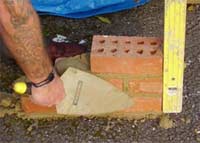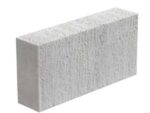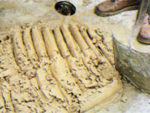From the earliest times rocks, boulders and stones have been used to provide shelter for man. The Romans and Egyptians before them used lime and gypsum cement mixed with some sand to form a mortar which bound the materials together to form both house walls and garden, or boundary walls.

Make sure everything is level when you are laying bricks
As man became more dexterous and tools more advanced, it was possible to shape the stones so they lay together in space saving ways which made the construction more stable and solid.
In 7000BC (dates used are from The History of Brickmaking) tribes were experimenting with forming shapes from moulding clay into rectangles and the first brick walls were seen. The clay was moulded and fired in ovens.
Other than timber, bricks are still the most commonly used of all building materials and different materials are used for different colours and textures of brick. The different properties of the materials used allow for bricks to be used which are deliberately processed for certain jobs. A Class A Engineering brick for example has to have an absorbtion rate of less than 4.5% and as such is ideal for work below ground (E.G. Manholes and Inspection chambers).
As well as class A and class B engineering bricks there are:
- Waterstruck bricks – An alluvial clay brick made in a special mould to give a handmade appearance.
- Arch and Clinker bricks – As Clinker would suggest, these bricks are well burned leading to a good quality, hard brick.
- Concrete or cement bricks – Mass made from Portland cement in concrete moulds these bricks can be made as construction bricks or paving bricks depending on the area they are to be used.
- Wirecut bricks – A whole bed of clay is cust into brick shapes using a wire as one would cut cheese.
- Fletton bricks also called London Bricks – These are bricks made from clay from the S.E. of England. This clay is slightly oily which, when burned off, leaves a hard and brittle brick.
An overall guide to brick quality is that the closer to the heat of the kiln, the better quality the brick.



